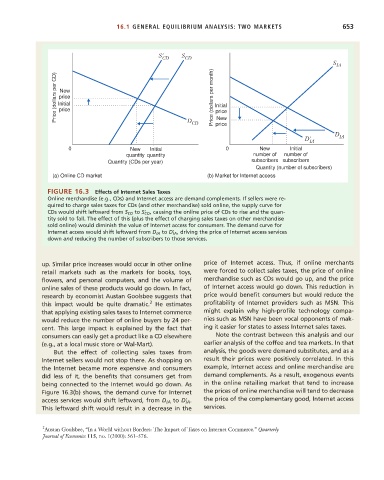Page 679 - Microeconomics, Fourth Edition
P. 679
c16GeneralEquilibriumTheory.qxd 8/16/10 9:13 PM Page 653
16.1 GENERAL EQUILIBRIUM ANALYSIS: TWO MARKETS 653
S' CD S CD
S IA
Price (dollars per CD) Initial Price (dollars per month) Initial
New
price
price
price
New
D
CD
price
D
D' IA IA
0 New Initial 0 New Initial
quantity quantity number of number of
Quantity (CDs per year) subscribers subscribers
Quantity (number of subscribers)
(a) Online CD market (b) Market for Internet access
FIGURE 16.3 Effects of Internet Sales Taxes
Online merchandise (e.g., CDs) and Internet access are demand complements. If sellers were re-
quired to charge sales taxes for CDs (and other merchandise) sold online, the supply curve for
CDs would shift leftward from S CD to S¿ CD , causing the online price of CDs to rise and the quan-
tity sold to fall. The effect of this (plus the effect of charging sales taxes on other merchandise
sold online) would diminish the value of Internet access for consumers. The demand curve for
Internet access would shift leftward from D IA to D¿ IA , driving the price of Internet access services
down and reducing the number of subscribers to those services.
up. Similar price increases would occur in other online price of Internet access. Thus, if online merchants
retail markets such as the markets for books, toys, were forced to collect sales taxes, the price of online
flowers, and personal computers, and the volume of merchandise such as CDs would go up, and the price
online sales of these products would go down. In fact, of Internet access would go down. This reduction in
research by economist Austan Goolsbee suggests that price would benefit consumers but would reduce the
2
this impact would be quite dramatic. He estimates profitability of Internet providers such as MSN. This
that applying existing sales taxes to Internet commerce might explain why high-profile technology compa-
would reduce the number of online buyers by 24 per- nies such as MSN have been vocal opponents of mak-
cent. This large impact is explained by the fact that ing it easier for states to assess Internet sales taxes.
consumers can easily get a product like a CD elsewhere Note the contrast between this analysis and our
(e.g., at a local music store or Wal-Mart). earlier analysis of the coffee and tea markets. In that
But the effect of collecting sales taxes from analysis, the goods were demand substitutes, and as a
Internet sellers would not stop there. As shopping on result their prices were positively correlated. In this
the Internet became more expensive and consumers example, Internet access and online merchandise are
did less of it, the benefits that consumers get from demand complements. As a result, exogenous events
being connected to the Internet would go down. As in the online retailing market that tend to increase
Figure 16.3(b) shows, the demand curve for Internet the prices of online merchandise will tend to decrease
access services would shift leftward, from D IA to D IA . the price of the complementary good, Internet access
This leftward shift would result in a decrease in the services.
2 Austan Goolsbee, “In a World without Borders: The Impact of Taxes on Internet Commerce.” Quarterly
Journal of Economics 115, no. 1(2000): 561–576.

